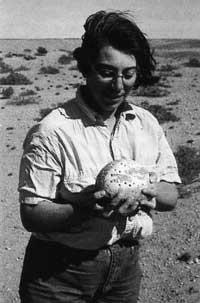Giant fossil eggs

In Namibia, fossil eggs of 15.5 x 14.3 centimeters have been found in lands of the lower Miocene. The volume of each egg is 1.7 liters, and as there are no bone remains in the area, both researchers and animals cannot be invented. It shows that infrared photometric spectra are not turtle. They may belong to a large bird similar to ostriches and lived in the time (baptized as Diamantornis wardi). Ostrich eggs have a volume of between 1 and 1.2 liters, so it is believed that the bird was like ostriches, but in reality no one knows what the Diamantornis wardi was like.
The bark of bird eggs is usually calcite and aragonite turtle (calcium carbonate). Since the eggs found in Namibia are calcite, some birds are considered to be laying.
Another peculiarity of these Namibian eggs is that they present on their surface pores up to 2-8 millimeters in diameter (ostrich eggs have up to a millimeter). Their goal seems to be to let the embryo breathe. The bark of the egg is between 2.8 and 3.9 millimeters thick and that of the ostrich barely exceeds 2 millimeters.





